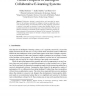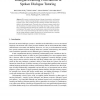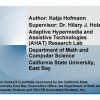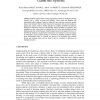AIED
2005
Springer
14 years 5 months ago
2005
Springer
Collaborative learning is question-driven and open-ended by nature. Many of the techniques developed for intelligent tutoring are applicable only in more structured settings, but f...
AIED
2005
Springer
14 years 5 months ago
2005
Springer
A well-known challenge of adaptive educational systems is the need to develop intelligent content, which is very time and expertise consuming. In traditional approaches a teacher i...
AIED
2005
Springer
14 years 5 months ago
2005
Springer
AIED
2005
Springer
14 years 5 months ago
2005
Springer
We examine correlations between dialogue characteristics and learning in two corpora of spoken tutoring dialogues: a human-human corpus and a humancomputer corpus, both of which ha...
AIED
2005
Springer
14 years 5 months ago
2005
Springer
ITS instruction may be enhanced by models of student motivation and mood, in addition to cognitive skills and domain knowledge. In an initial study, self-assessments by high school...
AIED
2005
Springer
14 years 5 months ago
2005
Springer
Measuring the efficacy of ITS can be hard because there are many confounding factors: short, well-isolated studies suffer from insufficient interaction with the system, while longe...
AIED
2005
Springer
14 years 5 months ago
2005
Springer
AIED
2005
Springer
14 years 5 months ago
2005
Springer
Students approach the learning opportunity offered by intelligent tutoring systems with a variety of goals and attitudes. These goals and attitudes can substantially affect student...
AIED
2005
Springer
14 years 5 months ago
2005
Springer
The research literature investigating the construction of tutorial dialogue and learning companion environments present parallel experiences in attempting to emulate what has been ...
AIED
2005
Springer
14 years 5 months ago
2005
Springer
Time on task is an important predictor for how much students learn. However, students must be focused on their learning for the time invested to be productive. Unfortunately, stude...




